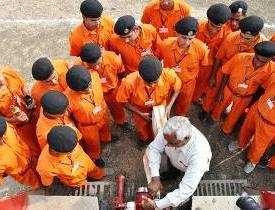Description
Course Name: Diploma in Fire Safety Management
Course Id: DSM/Q0001.
Education Qualification: 10th Pass.
Duration: 370 Hrs.
How You will Get Diploma Certificate:
Step 1- Select your Course for Certification.
Step 2- Click on Enroll Now.
Step 3- Proceed to Enroll Now.
Step 4- Fill Your Billing Details and Proceed to Pay.
Step 5- You Will be Redirected to Payment Gateway, Pay Course and Exam Fee by Following Options.
Card(Debit/Credit), Wallet, Paytm, Net banking, UPI and Google pay.
Step 6- After Payment You will receive Study Material on your email id.
Step 7- After Completion of Course Study give Online Examination.
Step 8- After Online Examination you will get Diploma Certificate soft copy(Scan Copy) and Hard Copy(Original With Seal and Sign).
Step 9- After Certification you will receive Prospect Job Opportunities as per your Interest Area.
Online Examination Detail:
- Duration- 120 minutes.
- No. of Questions- 60. (Multiple Choice Questions).
- 10 Questions from each module, each carry 10 marks.
- Maximum Marks- 600, Passing Marks- 40%.
- There is no negative marking in this module.
| How Students will be Graded: | ||
| S.No. | Marks | Grade |
| 1 | 91-100 | O (Outstanding) |
| 2 | 81-90 | A (Excellent) |
| 3 | 71-80 | A (Very Good) |
| 4 | 61-70 | B (Good) |
| 5 | 51-60 | C (Average) |
| 6 | 41-50 | P (Pass) |
| 7 | 0-40 | F (Fail) |
Benefits of Certification:
- Government Authorized Assessment Agency Certification.
- Certificate Valid for Lifetime.
- Lifetime Verification of Certificate.
- Free Job Assistance as per your Interest Area.v
Syllabus
Diploma in Fire Safety Management
Fundamentals of Fire Science
fire safety objectives, organization of module, fire hazards, fire performance of materials, fire performance of materials, fire tetrahedron, fire as a chemical reaction, flaming combustion oxidant, ignition sources, sample quiz questions, heat transfer in fires, conductive heat transfer, room fire dynamics, pre flashover fires, smoke production, fire safety concepts tree, the provision of fire safety, fire alarm systems, detection devices, fire signature, aerosol detectors, gas sensing detectors, fire detection system concerns, theory of suppression, automatic suppression systems, suppression by the fire services.
Industrial Safety Management
Environment and Safety Philosophy, Appraisal, Analysis, Inspection and Control Procedures, Safety Engineering, Pollution Sources and Measurements, Safety Engineering, Fire Laboratory and First Aid Practical, Fire Engineering and Explosion Control, Industrial Hygiene and Occupational Health, Pollution Control Strategies, Environmental Analysis, Environmental Impact Assessment, Industrial Hygiene and Occupational Health Laboratory, appraisal, analysis, inspection and control procedures.
Fire Protection, Equipment’s Appliances
Course Information, Training System, Job Role, General Information, NSQF Level Compliance, Learning Outcome, Learning Outcome with Assessment Criteria, Trade Syllabus, Core Skill – Employability Skill, List of Trade Tools & Equipment, List of Tools & Equipment for Employability Skill, Format for Internal Assessment, Chemistry of Combustion, Fire Extinguishers, Hose & hose fittings, Hydrant & Fittings, Pump & Primers, Foam & Foam Making equipment, Extension Ladder, Breathing Apparatus set, Anatomy of Fire, Basic Physics, Small & Special gears, Hydraulics, First Aid & Resuscitation, Hazards & Risk.
Risk Management and Hazard Control System
Hazard identification and safety management, Human behavior, Risk assessment tools, Control strategies, Risk assessment scoping, Types of risk, Organizational incidents, Environmental risk management, failed mines, Mining methods, Regulation and safety, Sustainable mining and corporate risks, Risk Assessment Procedure, Evaluation of how severe the harm could be, Evaluation of how a hazard may cause harm, Determining the likelihood of harm occurring, Risk Assessment and Control Form, Infrastructure, Organization, Implement additional risk controls, Eliminate the Hazard, Control Measures, Monitor and Review.
Disaster Management, Emergency Planning & First AID
Hazard identification, Hazardous substance / inflammable liquid storage, Vehicular movement on highway, Inflammable Storage Areas, Fire and explosion, Electrical Shock, Gaseous Leakage, Accidents due to Vehicles, Slips & Falls (Man & Material), Collision with stationary/ moving objects, Drowning, Other Hazards, Natural Hazards, emergency management plan, emergency prevention plan, emergency response plan, emergency response for fire, Fire in Diesel Storage Area, emergency response for earthquake, emergency response for flood and dam failure.
Leadership & Communication
Engineering Mathematics, Physics for Electronics Engineering, Basic Environmental Science & Engineering, Basic Electronics Engineering, Engineering Graphics, Physics Lab, Basic Electronics Lab, Workshop, Chemistry for Electronics Engineering, Communication Skills, Basic Electrical Engineering, Electromagnetic Field Theory, Chemistry Lab, Communication Skill Lab, Basic Electrical Lab, Analog Electronics, Digital Electronics and Logic Design, Network Analysis and Synthesis, Communication Theory, Data Structure and Algorithm, Analog Electronics Lab, Digital Electronics Lab, Circuit Design & Simulation lab, Data Structure and Algorithm Lab, Electronic Measurement and Instrumentation Lab, Analog Communication Lab.

